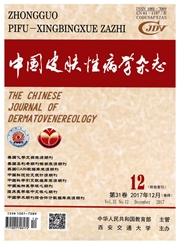

 中文摘要:
中文摘要:
目的探讨PQ.LRP基因对犬小孢子菌生长及毒力的影响。方法野生株和干扰株分别于沙氏培养基(SDA)培养观察菌落形态;米饭培养基行扫描电镜(SEM)透射电镜(TEM)观察超微结构;构建豚鼠感染模型行直接镜检和组织病理检查观察致病情况;液体沙氏培养基加入L一半胱氨酸,RT-PCR检测PQ—LRP基因沉默前后mRNA表达的变化。结果菌落形态:干扰株较野生株生长受限;豚鼠模型:干扰株较野生株不易感染宿主;致病豚鼠毛发皮屑真菌镜检:野生株为发内外孢子,孢子多,菌丝粗细均匀,干扰株为发外孢子,孢子少,菌丝粗细不一、弯曲不自然;豚鼠模型:野生株真皮及皮下组织见感染性肉芽肿改变,干扰株感染性肉芽肿改变不明显;半胱氨酸对犬小孢予菌PQ—LRP基因影响:野生株随半胱氨酸的浓度增加PQ.LRP基因表达水平呈上升趋势,干扰株PQ-LRP基因表达水平无规律性。结论PQ—LRP基因抑制后犬小孢子菌形态有变化、毒力减弱,推测PQ—LRP基因可能是犬小孢子菌致头癣的可能毒力基因之一。
 英文摘要:
英文摘要:
Objective To investigate the effect of PQ-LRP gene on the growth and virulence of Microsporum Canis. Methods The colonial morphology of wild and interference strains were observed, which were cultured in sabaurauds agar(SDA). The ultrastructure of the two strains cultured in rice medium was observed by scan- ning electron microscope and transmission electron microscopy. The two strains were inoculated in guinea pigs to bulid the infective models. Histopathology was done in the infective models. The expression of mRNA of PQ-LRP in the liquid sabouraud with L-cysteine was detected before and after the PQ-LRP gene was silenced by realtime PCR. Results The growth of interference strain was restricted. The interference strain did not in- fect the host more easily than the wild strain in the guinea pigs. There were more spores and intra-hair-shaft hypha in wild strains than in interference strain. The inflammatory granuloma was found in the guinea pig in- oculated with wild strain while the inflammation was not obvious in the guinea pig inoculated with interfer- ence strain. The expression of PQ-LRP of wild strain was upregulated in the higher concentration of L-cyste- ine medium. There was no similar result observed in interference strain. Conclusion The growth and viru- lence of Microsporum Canis was restricted when silencing the PQ-LRP. We suggested that PQ-LRP might be the one of pathogenesis genes of Microsporum Canis which leads to tinea capitis.
 同期刊论文项目
同期刊论文项目
 同项目期刊论文
同项目期刊论文
 期刊信息
期刊信息
